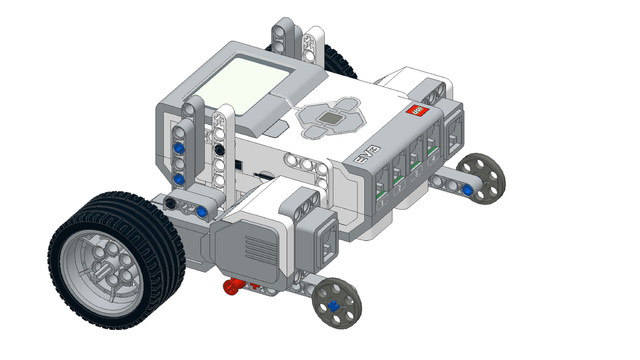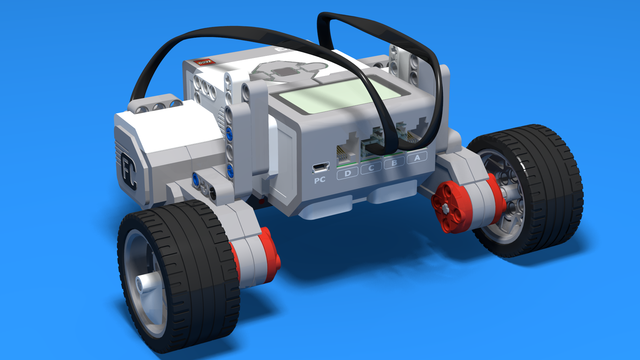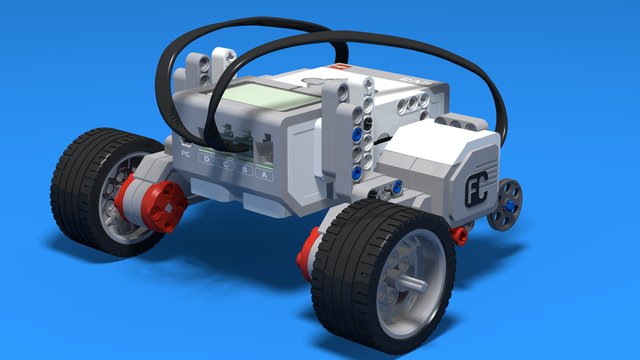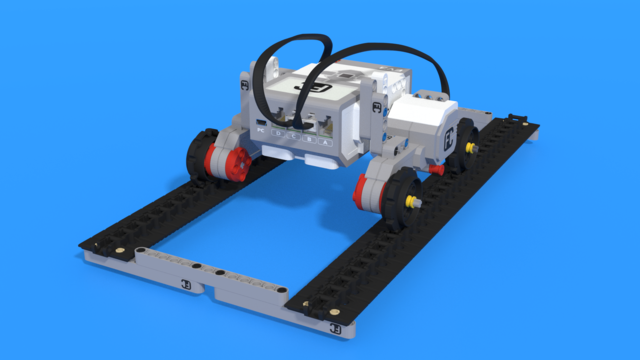Try to add a touch sensor to the robot on your own.
- #431
- 03 May 2017
- 2:06
The expected result
The touch sensor is connected rigidly to the robot and is pointing forward.
What is a stable construction
When applied a decent amount of force, the sensor must remain in its original position.
English
Your next task at this part of the course is to finally add a sensor to your robot. But what's interesting is that we are not providing you with any instructions on how to add the touch sensor to the robot. You have the robot, you have your box with all the parts in the box and you have the touch sensor. Now you should come up with a solution on how you can add this touch sensor to the robot. The goal at the end is to have the touch sensor pointing forward. But how exactly would you connect the touch sensor to the robot is part of the course where you should think of extending your current construction with new modules to add a touch sensor to the front of the robot. Try for a couple of minutes like 5, 10, 15 minutes and in the following videos we'll continue of course and we'll show you what we have built but try it yourself and try to come up with something unique. When you do don't forget to take a picture and a video of your robot and share this picture or video with us. One thing I forgot to mention is that at the end the sensor and the way the sensor is mounted to the robot the construction, the whole module here it should not allow the sensor to tilt. Or the whole construction should be very durable and stable. And we've seen a number of constructions where just the sensor is connected at just 1 point and it tilts down or up and it's not very stable. So, the sensor at the end it should not tilt. It should point forward.
Courses and lessons with this Tutorial
This Tutorial is used in the following courses and lessons

EV3 Phi. Introduction to robotics with LEGO Mindstorms
The things that you will be able to do with your EV3 robot by the end of this course are:
Freely move your robot towards desired target;
Avoid obstacles on the path of your robot using sensors;
Follow lines of any shape;
Detecting and picking up objects of any kind;
- 92
- 220:20
- 36

Extend the robot with a touch sensor. Building without instructions
Try to add a touch sensor to the robot on your own.
- 2
- 0
- 1
- 3d_rotation 0

Robotics with LEGO - Level 1.0 - Adventure in Space
The first level of the Robotics with LEGO curriculum for students in fifth to twelfth grades.
Various constructions with robots are built. Learn how to control the motors so that the robot navigates around the Moon and Earth in various ways. Getting to know the first two sensors. The robot can feel its surroundings with the help of the Touch sensor and avoid obstacles.
The Ultrasonic distance sensor can help the robot avoid obstacles. Students work with concepts like loop, degrees and medium motor. Robots can now do two different actions at the same time - while solving missions on a field, the third motor clears detected obstacles.
- 126
- 123:52
- 150

Level A1. Introduction. Robotics with LEGO
Introduction to robotics - The first level of the Robotics with LEGO curriculum for students in second, third or fourth grades. A journey in space, with robots. Various constructions with robots are built. Learn how to control the motors so that the robot navigates around the Sun, the Moon and Earth in various ways. Getting to know the first of the sensors. The robot can feel its surroundings with the help of the Touch sensor and avoid obstacles.
- 142
- 133:42
- 187

Lesson 6 - Touch sensor
In the next lesson we usually do a graduation. Write down your impressions about the students and the reasons why they have the grades you gave them.
- 10
- 3
- 6
- 3d_rotation 0

Python with LEGO Mindstorms EV3 - Level 2
In the second level of Python for EV3 robots, students learn in-depth the touch sensor. The sensor is used as an input device for manual control of machines, as well as a sensor for autonomous robots. In a pair of lessons, students build a control panel for the grabber and the movement of a crane. Programming wise, students learn how to fork code with "if-else" constructions, how to create conditional and forever loops with "while" and how to negate conditions with "not" operator. In the end of the lesson, robots can detect obstacles and avoid them, so that they traverse a simple labyrinth.
- 39
- 19:58
- 93

Lesson 7 - Passing through a tunnel
For students who will not take two levels in a row today is their last lesson.
- 10
- 3
- 8
- 3d_rotation 1

Python with LEGO Mindstorms EV3 - Level 2
In the second level of Python for EV3 robots, students learn in-depth the touch sensor. The sensor is used as an input device for manual control of machines, as well as a sensor for autonomous robots. In a pair of lessons, students build a control panel for the grabber and the movement of a crane. Programming wise, students learn how to fork code with "if-else" constructions, how to create conditional and forever loops with "while" and how to negate conditions with "not" operator. In the end of the lesson, robots can detect obstacles and avoid them, so that they traverse a simple labyrinth.
- 39
- 19:58
- 93

Lesson 6 - Automated vacuum cleaner
Introduction
Today we will create a robot that will behave like an automated vacuum cleaner!
One of the most annoying household chores an adult could have is cleaning their home. Which is why engineers invented the Roomba! And we're not talking about the dance, but rather a robotized home vacuum cleaner.

- 5
- 4
- 8
- 3d_rotation 1
